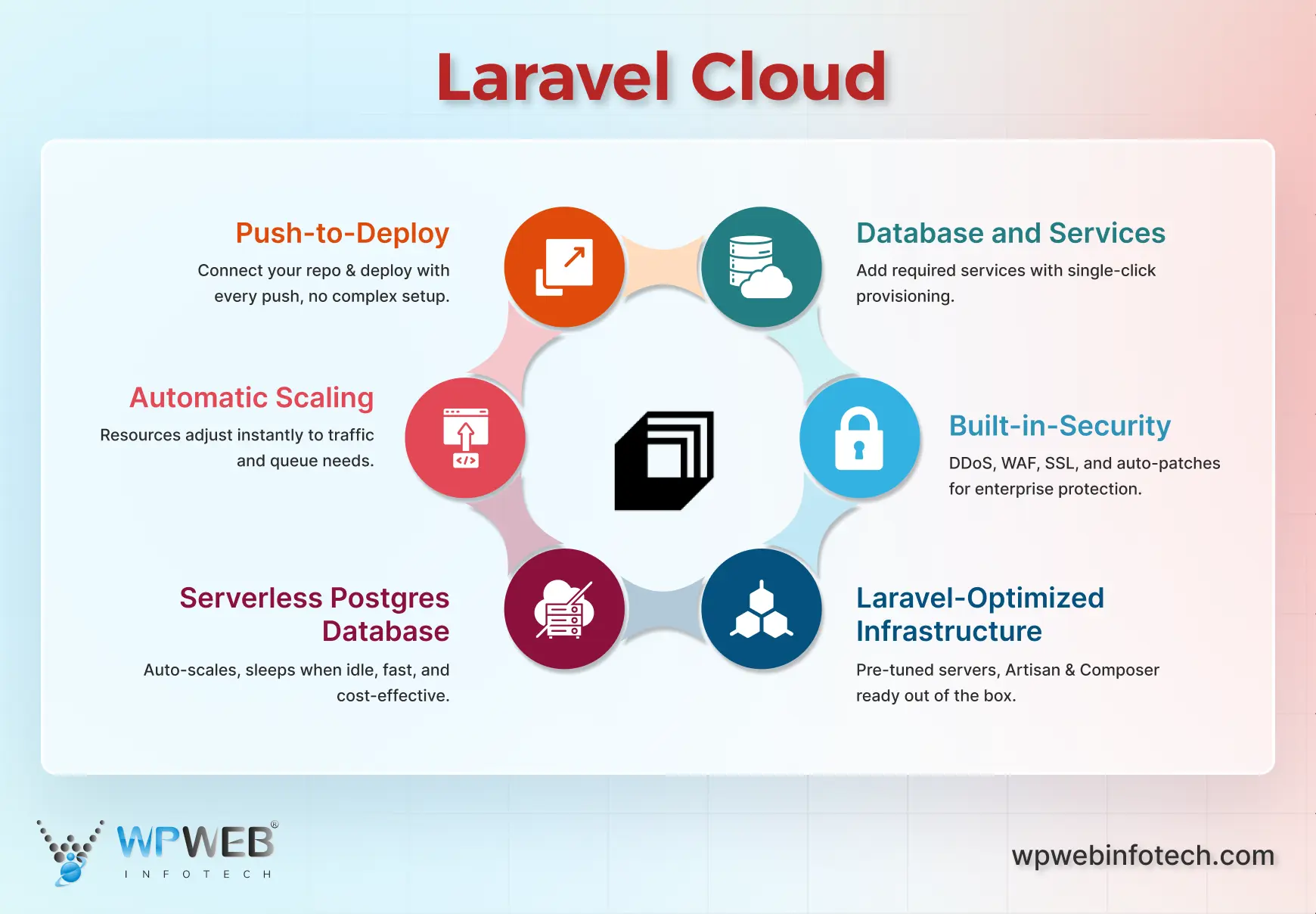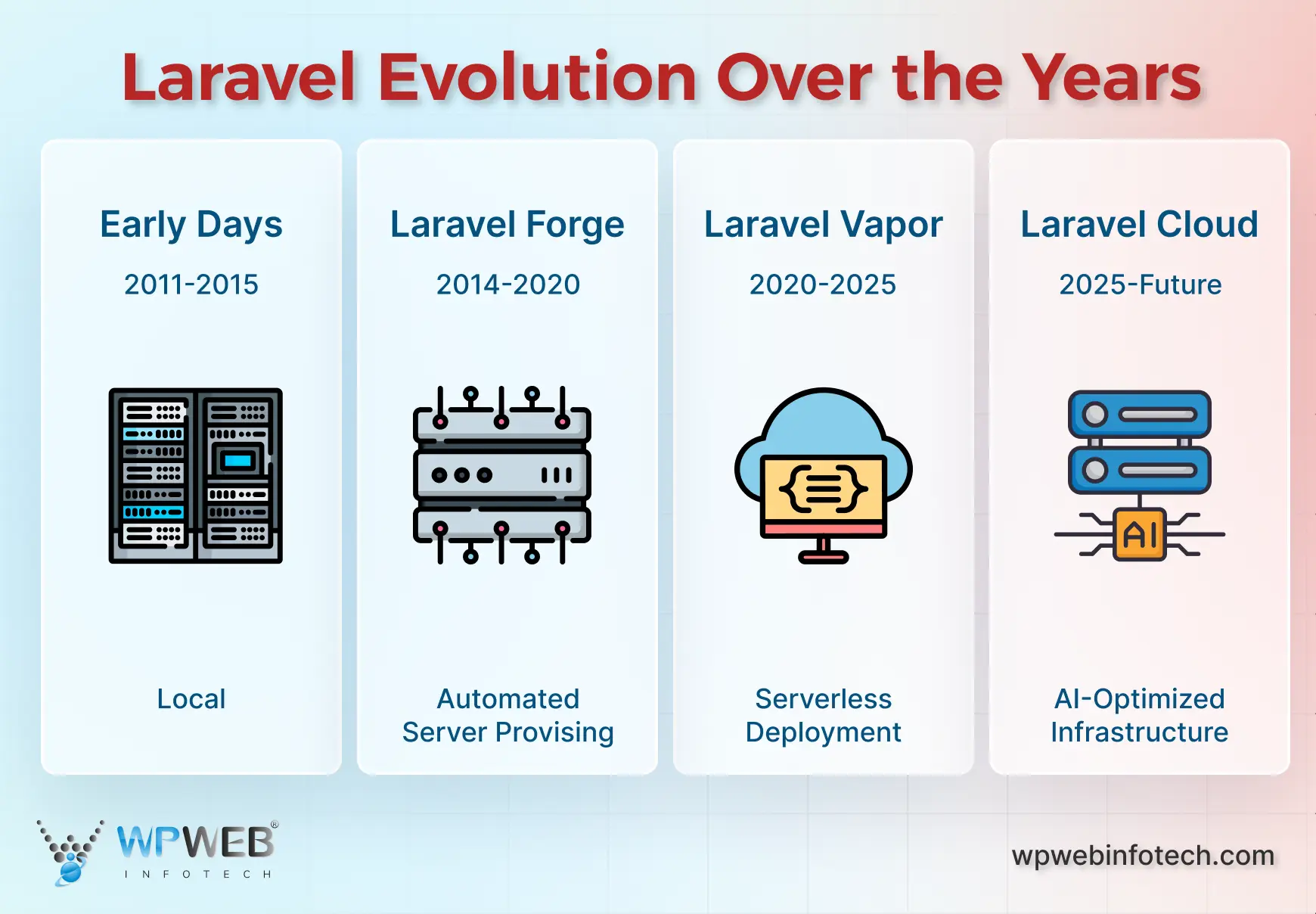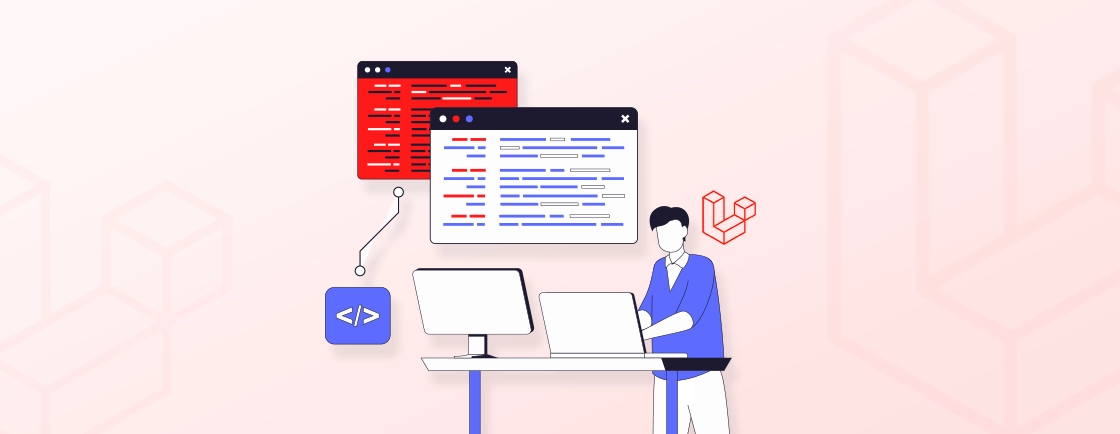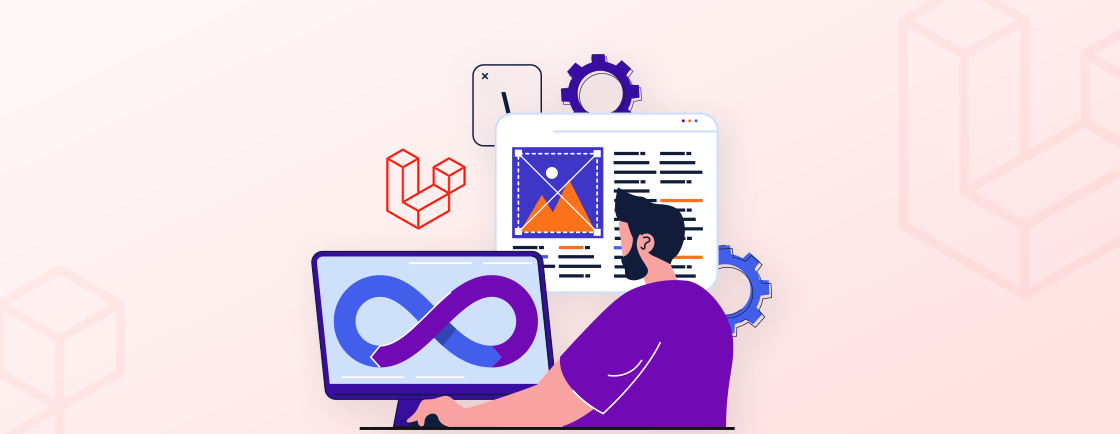Quick Summary
Laravel Cloud, a first-party hosting platform announced in early 2025, lets developers build and execute Laravel apps in the cloud to have a live URL in under a minute. Automatic deployments, predictable bandwidth pricing, cloud preview environments for pull requests, and an official VS Code extension for improved development workflows are 2025 Laravel Cloud updates!
Table of Contents
Deploying web apps has changed, and Laravel Cloud is now the best choice for Laravel developers. The release of Laravel Cloud on February 24, 2025, along with Laravel 12, marks a big shift from standard hosting to fully managed architecture. It automatically manages servers, gives enterprise-level security, and has smooth deployment processes.
What is Laravel Cloud and Why It Matters?
Laravel Cloud is the official platform for deploying and building Laravel applications. Most hosting options require you to maintain your servers manually. However, managed Laravel hosting through Laravel Cloud provides a comprehensive environment where scaling, security, and architecture are all taken care of automatically.
The purpose of the platform was to make it possible to get from signing in to a live URL in less than a minute. The Laravel team met this big goal and cut the time it takes to deploy to only 30 seconds. This serverless-like experience is powered by Amazon EC2 infrastructure.
Why Laravel Cloud is Better Than Other Hosting Options?

Laravel Cloud stands apart from conventional cloud hosting providers with all-new and updated features. The top benefits of Laravel Cloud hosting are:
- Push-to-Deploy Architecture: With this architecture, all you have to do is connect your Git repository and release with a single push. No need for a complicated CI/CD setup.
- Automatic Scaling: Based on real-time demand, the platform changes the number of compute resources, queue workers, and database performance.
- Serverless Postgres Database: An auto-scaling database that goes into hibernation mode when not in use to save money while keeping speed high.
- Built-in Security: DDoS protection, Web Application Firewall, SSL encryption, and automatic security fixes are all part of enterprise-level security.
- Laravel-Optimized Infrastructure: Server settings that are set up with tools like Artisan and Composer already set up to work well with Laravel.
These all-inclusive features make Laravel Cloud development faster and cheaper.
Getting Started with Laravel Cloud
Step-by-Step Guide to Set Up Your First Laravel Cloud Project
Setting up your first Laravel Cloud project is remarkably straightforward:
1. Account Creation: Sign up at cloud.laravel.com and connect your preferred Git provider.
2. Repository Selection: Choose the Laravel application repository from your connected provider.
3. Environment Configuration: Laravel Cloud automatically detects your application and configures environment variables.
4. Database and Services: Add required services with single-click provisioning.
5. Deployment: Click deploy and watch your application go live in seconds.
The entire process requires no server configuration or complex setup procedures. The platform requires a few Laravel application configuration adjustments. Most projects deploy without code changes. The Laravel Cloud setup process automatically configures web servers, databases, and cache layers to meet your application’s needs.
Integration with Existing Laravel Applications
Laravel Cloud hosting easily integrates with existing Laravel applications. The platform supports Laravel 8.x and higher, making migration straightforward. You can partner with a good Laravel development company for easy integration solutions. The top-most integration benefits are:
- Zero code changes required
- Automatic environment variable injection
- Native Laravel tool support
- External database connection capabilities
There are many ways for Laravel Cloud apps that use external services to connect to other systems. Through connector factors, the platform lets you use custom domains, SSL certificates, and third-party services. During deployment, automatic database migrations also make sure that the schema is the same across all platforms.
Simplifying Development with Laravel Cloud
How Laravel Cloud Eases Deployment and Scaling?
Laravel Cloud is the best Laravel cloud hosting platform because intelligent automation changes deployment methods. The platform monitors CPU, memory, and request volumes to automatically adjust resources, ensuring Laravel performance optimization through predictive scaling that enhances efficiency and reduces expenses.
The deployment process eliminates common hosting issues. Users can access apps during updates with zero-downtime deployments. The rollback option lets you fix issues immediately. Even during maintenance windows, intelligent platform routing distributes traffic among replicas, maintaining availability. These capabilities make Laravel Cloud development more stable than traditional deployment methods.
Automation, Monitoring, and Workflow Enhancements in Laravel Cloud
The platform provides automation and monitoring capabilities:
1. Real-time logging for debugging purposes
2. Built-in performance metrics and monitoring
3. Automated alerts and integration with AI tools
4. Direct command execution from the web dashboard
5. Automatic queue worker scaling based on demand
Automated workflows reduce operational overhead and ensure application reliability, making cloud Laravel solutions more advantageous than traditional hosting.
Laravel Cloud Pricing for 2025
Laravel cloud hosting platforms offer multiple pricing plans depending on the deployment options, service levels, and resource usage:
- Starter (Free): Usage-based pricing; no monthly fee. Fits small apps and testing environments.
- Growth ($20/month + usage): Get upgraded resources, networking, databases, and autoscaling. Bandwidth and storage beyond limits incur extra charges.
- Business ($200/month + usage): Best for production and teamwork with advanced networking and preview environments.
- Enterprise: Dedicated support and custom pricing for high workloads and complex environments.
Why Laravel Cloud is the Future of Hosting?
Laravel Cloud has strong benefits for many types of users, including:
For Developers:
Laravel Cloud delivers significant advantages across different user segments, establishing itself as the leading Laravel cloud hosting solution.
- Eliminates DevOps complexity completely
- Reduces deployment time from hours to seconds
- Provides Laravel-specific optimizations
- Offers predictable, usage-based pricing
The platform eliminates the need for specialized infrastructure knowledge, allowing teams to focus on Laravel cloud development rather than server management.
For Businesses:
With pay-as-you-use Laravel cloud price plans, businesses can be sure of their costs. The platform’s auto-hibernation feature reduces apps to zero when they’re not being used. This keeps costs low for applications that aren’t being used much.
Enterprise-level security features make sure that you follow industry standards like PCI DSS, GDPR, and HIPAA. Because it takes care of everything, Laravel Cloud is the best choice for businesses that want controlled Laravel hosting.
For Startups:
Startups benefit from Laravel Cloud’s pricing and open scalability.
- Low barrier to entry with pay-as-you-go pricing
- Scales from prototype to production seamlessly
- No upfront infrastructure investment required
- Focus resources on product development
Applications can start with a few resources and scale automatically as users develop. Without upfront infrastructure investments, the platform provides enterprise-level capabilities from day one.
Cloud Trends Driving Laravel Adoption in 2025
Several important trends help Laravel Cloud development grow:
1. Serverless-First Architecture: Businesses are choosing serverless options more and more because they make server maintenance easier.
2. Focus on Developer Experience: Businesses value tools that make them more productive and speed up the time it takes to get a product to market.
3. Cost Optimization: Companies look for ways to get prices to match up with real usage instead of reserved capacity.
4. Security Automation: There is a growing need for platforms that have built-in security that doesn’t need to be set up by hand.
Strategic regional deployment of edge computing reduces global application latency. With planned development, Laravel Cloud offers installations in US East (Virginia), US East (Ohio), EU West (London), EU Central (Frankfurt), Asia Pacific (Singapore), and Asia Pacific (Sydney). This global infrastructure strategy solidifies Laravel Cloud’s status as the top cloud hosting platform.
How Laravel Deployment Has Changed Over the Years?

Laravel Cloud automates server configuration, replacing manual server configuration. See the evolution of working with Laravel:
Early Days (2011–2015): Manual server configuration and shared hosting ruled.
Laravel Forge (2014–2020): Streamlined server provisioning but needed manual scalability.
Laravel Vapor (2020–2025): Serverless deployment with AWS complexity.
Laravel Cloud Revolution (2025-Future): Laravel Cloud improves and eliminates constraints.
Challenges Laravel Developers Faced Before Cloud Solutions
Old-school deployment methods caused several issues for developers before Laravel Cloud pricing came into the picture. Server provisioning needed Linux, web server, and security hardening expertise. Manual scaling caused over- or under-provisioning during low-traffic times.
In pre-Laravel Cloud development, database administration was complicated. Developers manually configured backups, monitored performance, and scaled. Managed Laravel hosting solutions are necessary due to the divergence of development resources from essential application functionalities.
WPWeb’s Insights – Work with Laravel Cloud Today!
WPWeb’s Laravel Cloud beta testing yielded dramatic outcomes across numerous application settings. Hire Laravel developers from us to get an edge on cloud service implementation. Have a look at what we found while we worked on the same:
1. Intelligent auto-scaling during peak shopping periods sped up e-commerce checkouts by 40%. Integrating managed Laravel hosting features eliminated deployment barriers for SaaS apps.
2. A finance business switched to Laravel Cloud from traditional Laravel cloud hosting. The program automatically managed 10x traffic spikes during financial market volatility.
3. Laravel Cloud’s predictive scaling algorithms deployed capacity before demand peaked, ensuring sub-200ms response times throughout the crisis.
4. Educational sites using Laravel cloud development showed significant user engagement gains. Video streaming is simply integrated with Laravel Cloud’s CDN.
5. Even with thousands of spectators, live lectures had no buffering. Auto-hibernation cut off-peak costs by 60%.
6. Laravel Cloud’s enterprise-grade security was shown in healthcare apps. Automatic encryption and access controls satisfied HIPAA regulations.
7. Medical records processed through Laravel cloud hosting architecture maintained data integrity and enabled real-time healthcare provider communication.
Pro Tip: Deploy several edge locations via Laravel Cloud’s CDN and analyze latency by area to dynamically optimize placement and capacity for global users.
The Way Forward
Laravel Cloud is the definitive Laravel cloud hosting solution, advancing Laravel Deployment technology. The economic benefits go beyond lower operational expenses. Development teams can accelerate product development by focusing on feature development rather than infrastructure management. Businesses benefit from predictable Laravel cloud pricing and enhanced application reliability with this powerful platform.
Apart from that, modern Laravel cloud development projects benefit from Laravel Cloud’s future growth and scalability. Faster deployment cycles, better application performance, and higher developer productivity provide early Laravel Cloud adopters an edge. The platform evolves to optimize apps for the cloud Laravel ecosystem, technologies, and best practices.
FAQs on Laravel Cloud
Is Laravel still relevant in 2025?
Yes, Laravel is still very useful in 2025. Modern web development trends are still being taken into account by the framework, which now supports microservices design, API-first development, and cloud-native deployment strategies. Laravel’s busy community, constant improvement, and Laravel Cloud’s managed hosting features make it a tool that will always be useful for building web apps.
Is Laravel Cloud free?
Laravel Cloud has a plan called “Starter” that doesn’t charge a monthly fee. Instead, you only pay for what you use. The platform has auto-hibernation features that turn off apps when they’re not being used, which saves money. It’s a competitive managed Laravel hosting option because it comes with more plans that offer better features and more resources for growing applications.
Does Laravel Cloud use AWS?
Yes, Laravel Cloud is built on hardware from Amazon Web Services (AWS), and it uses EC2 servers for computing power. But unlike raw AWS services, Laravel Cloud hides the complexity of managing AWS and instead offers a simple interface that works best with Laravel apps. This method lets writers who don’t know a lot about AWS use cloud Laravel deployment.
How can Laravel Cloud connect to a database?
Laravel Cloud works with a number of different databases, such as controlled MySQL databases and serverless Postgres databases. The platform sets up database connections and adds the right environment variables immediately. Laravel Cloud also lets you connect to external databases for apps that need special database configurations. This gives you more options when working on your projects in Laravel Cloud.
Talk to Our Laravel Cloud Experts
Have questions or need help with Laravel Cloud deployment? Our team is ready to guide you toward seamless, scalable hosting solutions.





